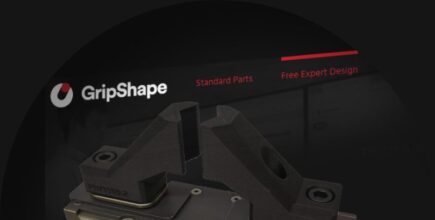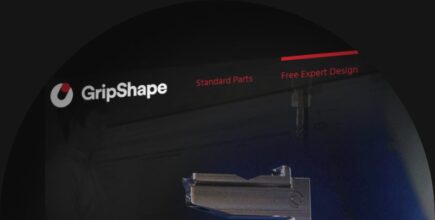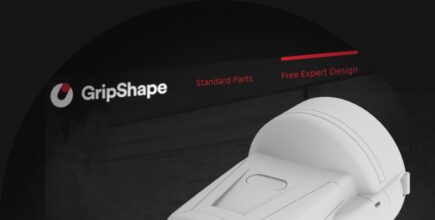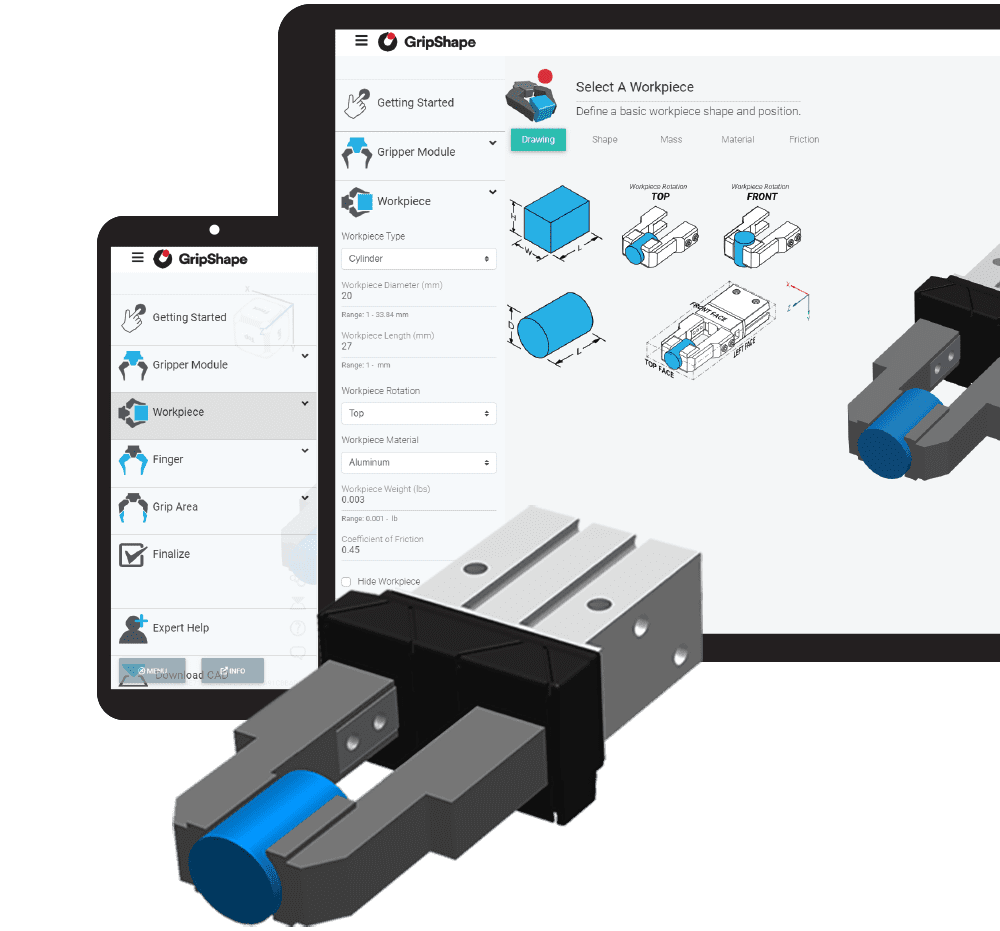Introduction to Robot Grippers

The manufacturing industry used to be geared towards long, dedicated runs producing single products at very high speed. Due to an increase in product turnover, quality demands and drive to decrease manufacturing costs many factories have been forced to turn to automation and custom grippers. By having a rapidly configurable automation system, companies are better equipped to adapt to the ever changing demands on their manufacturing process.
One key component of the configurability of the automation system is the robot gripper module. The gripper module is an actuator with jaws that grasps an object and allows the workpiece to be picked up, transferred and placed by the robot. They are typically mounted at the end of a robot arm and at the point of contact with the workpiece. Automation components such as robot arms and software are flexible enough to be programmed for a wide variety of tasks and therefore, can be reused to produce multiple variants of products. However, the gripper module can be very specific to one task and is often specifically chosen and outfitted with tools to help with the issue of configurability.
Considerations for Gripper Selection and Design
When determining which gripper is best suited for the project, there are many factors that are specific to your application that must be taken into consideration, but it is best practice to try and keep it as simple as possible. Below are some concepts to help better understand the different types of gripper modules and some basic design considerations to follow.
Gripper Footprint is important in the design process because it determines how much available space is needed in the environment for the gripper to grasp the object without interference from other surrounding objects.This has become more important with the advancement of vision systems which allow the workpiece to be presented in non-traditional ways such as laying randomly on a conveyor or in bulk containers.
Power Types of different varieties are used to drive the gripper actuation with the main two being pneumatic or electric. Selecting a power source can be as simple as what is available on the factory floor but can also have more specific impact on the design of the automation system.
Pneumatic grippers use compressed air to drive a cylinder mechanism inside the gripper body, translating the motion to open and close the jaws. The wide availability of compressed air on most facilities and the simple on-off action of the gripper make it a popular choice for industrial applications. Very few parameters can be controlled using a pneumatic gripper and the force being applied to the object can only be controlled through the air pressure being supplied to the gripper. Due to the lack of adjustability, each module is generally set up for one specific task and often requires custom finger components to interface with the workpiece.
Electric grippers useservos and other style motors to open and close the jaws of the gripper. This allows for precise control over position and the stroke of the gripper when trying to program multiple positions. Some models offer the velocity and acceleration to be customized which would add flexibility to the gripper module making it ideal for varying sized or smaller, delicate parts. Electrical grippers are great for applications where compressed air is not accessible or may not be allowed around the process such as clean rooms. Electric grippers often require external controllers and other power related equipment to operate and may not be as simple to program.
Gripper Sizing is very important to the functionality and safety of the overall gripping system.Robot payloads are restrictive, especially when moving the part around at higher speeds so the gripper should be sized as small as possible while still allowing the set of tasks to be performed by the robot. In fact, in terms of weight, all objects that will be attached to the robot arm or gripper module during the operation should be calculated into this weight consideration. This would include anything mounted to the module such as the gripper fingers, tool changers, sensors, etc. It is important to make sure the gripper can physically open up enough to grasp the workpiece and has enough gripping force recommended by the manufacturer to secure the workpiece through the duration of the motion. Understanding the amount of stroke needed for a gripper module to clear the workpiece when approaching or releasing the object is critical to the gripper design and is more complicated to determine due to many variables like the amount of material overlapping the workpiece in the gripper finger design. Care should be taken to make sure the percent of stroke at contact leaves enough stroke to safely and efficiently get off of the workpiece without interference.
Maintenance requirements are different depending on the style of gripper you have selected, but should be taken in consideration when determining the longevity of the unit or resources needed to keep the gripper running efficiently. Many grippers require lubrication to ensure even jaw wear and should be kept clean to prevent debris from damaging the moving parts of the gripper. The lifecycle rating for grippers can range from ten thousand upwards to ten million cycles and is an important factor to consider when looking at the overall cost of the unit. Due to the electronics involved electrical style grippers, they may be more susceptible to damage when working in environments with high moisture levels or areas in which they may get heavily soiled. Pneumatic grippers only require two air lines and are less prone to failure if working in these tough environments.
Gripper Actuation Types
Mechanical grippers can be grouped into categories when describing how the gripper actuates and can aid when selecting which gripper module will best suit your application. The most common actuation patterns are parallel, angular and translational.
Parallel grippers are the most simple to program because they actuate by using a linear motion on one plane to move two or more jaws in relation to one another. An example of this style gripper is the Schunk PGN-plus series. This type of actuator is perfect for applications where space is an issue and the workpiece needs to fit into another part where the fingers would not normally have room to pivot out of the way. Parallel grippers normally come with two or three jaw setups. The three jaw grippers help center the workpiece by providing a third contact point forcing the workpiece into the center of the grasp.
Angular grippers like the SMC MHC2 work by translating linear motion into pivoting the jaws around a single point giving the gripper the ability to pick up large, odd shaped objects. By utilizing this pivoting action, the jaws can be easily arched further out of the way to give more access to a workpiece.
Translational movements are not as common in grippers but have become more popular with the invention of collaborative robotics designs such as Robotiq’s 2-F85. This style of gripper uses a linear motion along with specially designed linkages to keep the gripping faces normal to a plane while the module linkages arch to open and close. This allows the gripper to move back and away from the object creating significant space on approach.
Adaptive Grippers
As gripping requirements have become more complex, engineers have developed self-adaptive mechanisms coupled with vision systems to identify and grasp objects that have diverse geometries or presented in random orientation. These under-actuated grippers usually have one or two actuators, but can move in up to six degrees of freedom by utilizing springs and other passive components as seen in the Robotiq 3-Finger gripper. The fingers can then adapt as the gripper is closed around an object and can perform a wide variety of grasping depending on the objects size, shape and position. Some examples are pinching the workpiece where the object is grasped narrowly between the tips of all the fingers, encompassing where the fingers pivot and wrap all the way around the workpiece, and a scissor style grip where the object is secured between two fingers on the same side of the gripper by moving the two fingers laterally toward each other pinching the workpiece between the sides of the finger tips.
Specialty Grippers
Needle Grippers are an intrusivestyle gripper where needles are protruded from the gripper body inwards towards each other at an angle. This provides a grip that is both friction and mechanical grasping from the penetration of the needles and the angle in which they enter the workpiece. Needle grippers are most commonly used in the transportation of textiles, fiber composites or other porous materials where vacuum is not suitable.
Magnetic Grippers are designed to work with ferromagnetic workpieces where gripping may not be ideal. They work well in applications where space is a premium and can easily handle varieties workpieces with very little setup due to not having to work around specific geometries. Many of the modern electromagnetic gripper modules have safety features built in preventing deactivation of the magnet even when power is lost.
Accessories
Torque Sensors are attached to the robot arm along with the gripper. The sensor measures force and torque in up to six degrees of freedom and passes that data back to the robot controller allowing for corrections to the path or motion of the robot. This type of system works well for complex assembly operations where tolerance is small or in pressure sensitive applications like sanding or buffing.
Tool Changers are a key part of an automation system where multiple grippers or peripheral tooling must be changes on the end of the robot in order to complete a task or a set of tasks while maintaining the dimensional accuracy and repeatability of the robot arm itself. This reduces overall capital expense when implementing a single robot to perform multiple operations efficiently and can help reduce the manufacturing time needed to produce a product. Tool changers like the ones from ATI Industrial Automation consist of a base that is attached to the robot arm and each tool would need a corresponding coupling to interface with the robot. Manual and pneumatic versions are available.
Positional Sensors can be used to increase the performance of the robot allowing greater precision and accuracy by sending real-time information back to the robots controller. These sensors can interpret information such as proximity to an object, pitch and roll of the robot appendage, rotation, acceleration, and even shock or vibration. Not only can this information be used to monitor or update the path or motion of the robot in real-time, it can be useful for gathering important data regarding the condition of the robot. An example may be using vibration monitoring to detect worn bearings, insufficient lubrication, broken or missing components.
Rotary Units operate by allowing 360° of movement on a single plane andcan be used in end of arm tooling to allow for rotational movement of the gripper without the additional expense of a multi-axis robot arm or in applications that simple don’t require the complex movements of such robots. When outfitted with two mechanical grippers, the rotary action of the unit can increase efficiency by allowing the robot to handle multiple workpieces without setting them down between operations like in machine tending where one gripper unloads a finished part from the machine and rotates 180° to insert the unfinished part using the other gripper. Specifying a rotary unit can be complex and involves knowledge of the workpiece mass, angle of rotation, torque applied, inertia and the location of the workpiece in relation to the center of the spindle. Some companies have an online solution for helping determine which rotary actuator unit is appropriate like SMC’s Rotary Actuator Model Selection Software.
About Fairlane
Fairlane was established in 1957 in Fraser, MI and designs, manufactures and stocks a wide range of standard components used in positioning and workholding applications. Fixtureworks, a related business, supplies an extended range of standard machine components and complete workholding solutions from work leading manufacturers. Recently Fairlane has developed a web-based design application aimed at the end of arm tooling industry. It uses intuitive CAD to help users design and purchase custom gripping components in minutes.
To learn more visit www.FairlaneProducts.com




